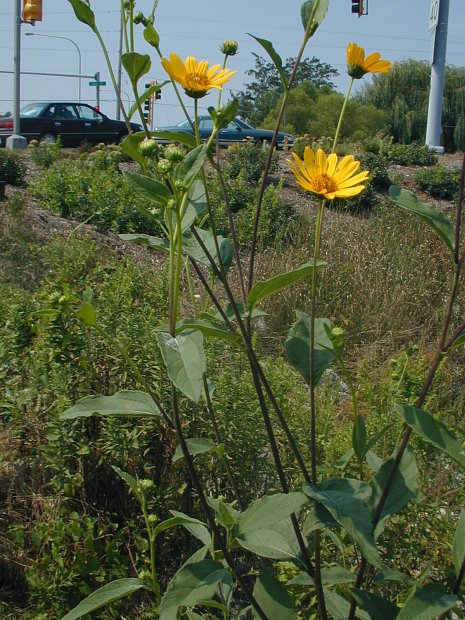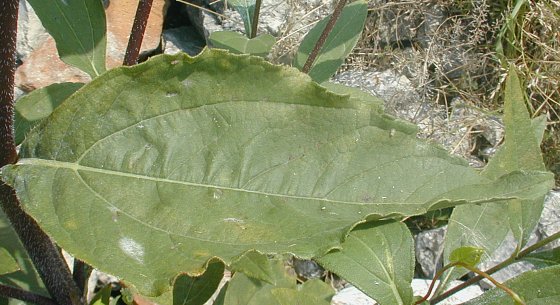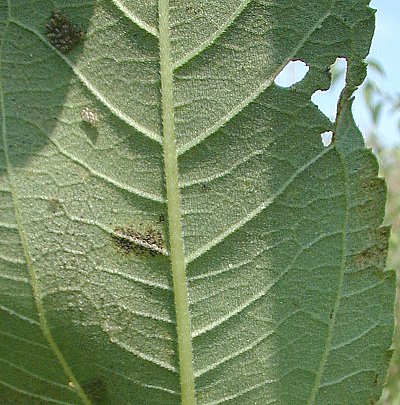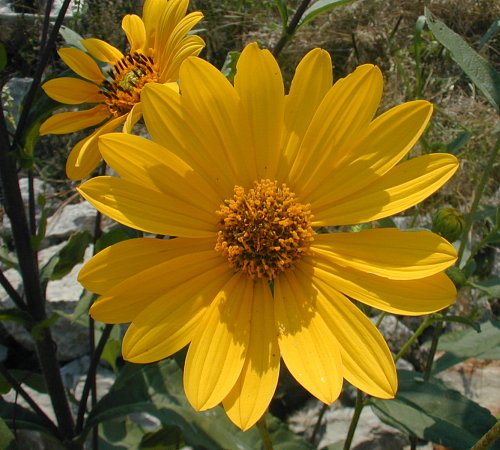Description: This herbaceous perennial plant is 2-8' tall, branching occasionally along the upper one-half of its length. The stems are light green to reddish brown, terete, and hairy; the stem hairs are white, widely spreading, and slightly stiff. Either opposite or alternate leaves occur along lower to middle stems of this plant, while alternate leaves occur along the upper stems. There is some variation across populations to what extent the leaves are opposite or alternate. The leaf blades are up to 9" long and 4" across, although they are usually closer to one-third or one-half of this size. The leaf blades are lanceolate to ovate in shape and nearly entire (toothless) to serrate-dentate along their margins. The bases of leaf blades are wedge-shaped to rounded, while their tips are acute. The upper blade surface is medium green and nearly glabrous to minutely stiff-hairy, while the lower blade surface is pale-medium green and minutely stiff-hairy to short-pubescent. The hairiness of the leaf blades varies to some extent across different populations of plants. The petioles of the leaves are ¼–2½" long, becoming increasingly winged toward their blades; they are light green and minutely stiff-hairy to pubescent. The petioles become progressively shorter as they ascend along the stems. The upper stems terminate in one or more flowerheads on peduncles up to 8" long. The peduncles are similar to the stems in their characteristics.

Each flowerhead spans 2½–3½" across, consisting of a dense
head of disk
florets that are surrounded by 10-20 ray florets. The corollas of the
disk florets are about ¼" long, narrowly tubular in shape, yellow, and
5-lobed at their apices. The petaloid rays of the flowerheads are
yellow and elliptic-oblong in shape. At the base of each flowerhead,
there are medium green phyllaries (floral bracts) that are arranged in
2-3 overlapping series. These phyllaries are lanceolate-triangular to
ovate-triangular in shape and either appressed together or slightly
spreading; their margins are usually ciliate. The blooming period
occurs from late summer into autumn, lasting 1-2 months. Afterwards,
fertile disk florets are replaced by achenes. At maturity, these
achenes are about ¼" (6 mm.) long, oblongoid-oblanceoloid in shape,
somewhat flattened, and glabrous to slightly downy. The apices of these
achenes have tiny deciduous scales that soon fall off. The root system
is fibrous, rhizomatous, and tuberous. The tubers are fusiform to
rounded-chunky in appearance and relatively large (often 2" or more
across). Clonal colonies of plants are often produced from the rhizomes
and tubers.

Cultivation:
The
preference is full to partial sun, moist conditions, and soil
containing fertile loam. During hot dry weather, the leaves may wilt
conspicuously or the lower leaves may fall off, but this plant recovers
readily after significant rainfall. Foliar disease usually isn't a
problem until autumn, when powdery mildew on the leaves may develop.
During a wind storm, this plant may topple over while it is in bloom.
In open situations with reduced competition, this plant has a tendency
to spread aggressively.
Range & Habitat:
Jerusalem
Artichoke occurs throughout most of Illinois, except a few
counties in southern and NW Illinois (see Distribution
Map).
Overall, it is a fairly common plant; there are both native
populations and plants that have escaped cultivation within the state.
Habitats include
moist to mesic black soil prairies, prairie remnants along railroads,
moist meadows along rivers, woodland
borders, thickets, roadsides and areas along
railroads, slopes of ditches and drainage canals, and miscellaneous
waste areas. Jerusalem Artichoke
is usually more common in disturbed areas.

Faunal Associations: The nectar and pollen of the flowers attract primarily bees, including bumblebees, cuckoo bees (Triepeolus spp.), digger bees (Melissodes spp.), leaf-cutting bees (Megachile spp.), Halictid bees, and Andrenid bees. Bees that are specialist pollinators (oligoleges) of sunflowers (Helianthus spp.) include a digger bee (Melissodes agilis), some Andrenid bees (Andrena accepta, Andrena aliciae, Andrena helianthi), a dagger bee (Pseudopanurgus rugosus), and a Halictid bee (Dufourea marginata marginata). Other floral visitors include Syrphid flies, bee flies (Bombyliidae), small to medium-sized butterflies, wasps, and beetles (Robertson, 1929, & others). These insects cross-pollinate the flowerheads. Other insects feed destructively on the foliage, stems, flowerheads, seeds, plant sap, and roots of sunflowers. The larvae of such butterflies as the Gorgone Checkerspot (Chlosyne gorgone), Silvery Checkerspot (Chlosyne nycteis) and Painted Lady (Vanessa cardui) feed on the foliage of these plants, as do the larvae of such moths as the Arge Tiger Moth (Grammia arge) and Ruby Tiger Moth (Phragmatobia fuliginosa). Larvae of the Frothy Moth (Plagiomimicus spumosum) feed on the seeds, while larvae of the Sunflower Borer Moth (Papaipema necopina), Rigid Sunflower Borer Moth (Papaipema rigida), and Maritime Sunflower Borer Moth (Papaipema maritima) bore through the stems.

Other
insect feeders include leaf beetles (Brachypnoea clypealis, Physonota helianthi,
Trirhabda adela),
weevils,
billbugs, plant bugs, larvae of leaf-mining flies, larvae of gall flies, larvae of fruit flies, aphids, treehoppers,
grasshoppers,
and thrips. The Insect Table shows
more information about these
insects. Among vertebrate animals, the seeds are an important source of
food for many birds, including the Bobwhite Quail, Mourning Dove,
White-winged Crossbill, and Eastern Goldfinch (see the Bird
Table for
more information). Mammals also use sunflowers in various ways. Their
seeds are eaten by the Thirteen-lined Ground Squirrel and other
rodents, while the Plains Pocket Gopher feeds on their roots and the
White-tailed Deer browses on their foliage (Martin et al., 1951/1961).
The tuberous roots of Jerusalem Artichoke are particularly attractive
to
pigs (Georgia, 1913), whether domesticated or wild. Horses, cattle,
sheep, and other domesticated farm animals browse on the foliage of
these plants. When sunflowers grow near creeks or ponds, their stems
are used by muskrats and beavers for the construction of their dens or
dams. Large colonies of sunflowers provide protective cover for many
kinds of wildlife.

Photographic
Location:
The photographs were taken along the rocky slope of a drainage ditch at
the Windsor Road Prairie in Champaign, Illinois.
Comments:
A better name for this sunflower would be 'Indian Potato' because the
native people of North America cultivated and ate the edible tubers,
which are produced in substantial quantities. These tubers have fewer
calories per gram than the familiar 'Irish Potato' (a South American
plant), and they are better for diabetics because the carbohydrates and
sugars can be assimilated by the digestive tract without insulin.
However, the tubers can produce flatulence in some people. Jerusalem
Artichoke (Helianthus
tuberosus) can be distinguished from other
perennial sunflowers (Helianthus
spp.) by its longer petioles
(often exceeding ½" in length) and wider leaves. Unlike most
sunflowers, the
stems of Jerusalem Artichoke are covered with spreading hairs. Finally,
the phyllaries (floral bracts) of its flowerheads are more wide and
triangular-shaped than those of most sunflowers; the latter usually
have linear-lanceolate phyllaries. The Annual Sunflower
(Helianthus annuus)
differs from Jerusalem Artichoke by having even
wider leaves that are more or less truncate at their bases, and the
central disks of its flowerheads (where the disk florets occur)
are more broad.